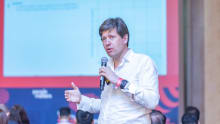Tech-ing Diversity to the next level: Making it a habit

TechHR Singapore 2019 Read similar articles

The working population today is intrinsically and inherently diverse – be it in terms of culture, geographies, ethnicity, generation or even working, learning and thinking styles and patterns. With a global workforce this diverse, it is no wonder that practices such as blind recruiting make sense in terms of avoiding bias.
That said, we might try to avoid and limit bias as far as possible, but at the end of the day, being human and emotional beings, we do give in to bias. Technically speaking, stereotyping is a cognitive shortcut that is aimed at saving time and aiding decision-making and in that regard, is helpful. The issue germinates when we link emotional valence to these shortcuts and that leads to bias and prejudice. Technology seems to be the answer to this problem – it can improve the speed and effectiveness of cognitive shortcuts without adding any emotional flavor.
Tech a check
Non-tech methods have been employed for many years whether in the form of holding blind auditions for orchestras or removing the names from college applications to eliminate bias in reviewing candidates have been around for decades. Tools like Textio’s online service flags gender-biased language in job-postings while also analyzing terms and phrases that might put applicants off. It also offers alternatives. Phrases like “driven by” and “ambitious goals” are often seen to resonate more with men while “collaboratively” and “be heard” statistically seem to play better with women when it comes to being attracted by a job post.
Machine learning principles are also used by formats like Search Party to find the best fits and thus match candidates to job descriptions. Human intervention at the initial screening stage can thus be done away with. With this new battalion of apps and tech tools that either work like dating apps to find the best person-organization matches or allow applicants to take work assessments anonymously, diversity is becoming an easier work aspect to embrace.
The culture conundrum
Embracing diversity does not mean turning a blind eye to our inherent differences. Rather, it involves acknowledging, appreciating, understanding and leveraging on our differences. People hailing from different cultures often have very divergent world-views, which feeds the us versus them complex. Organizations thus need to enable individuals across global teams to interact and share experiences and opinions. This, however, needs to be done in a constructive way that reinforces positive aspects of cultural intermingling. Our biases are often based on limited (or indirect) interaction with a small sample of a “different” population. Technology, having brought the world a lot closer, allows us access to many individuals from different sub-groups. This enables us to understand individual differences between people from the same cultural or social context while also bringing to the forefront, our similarities with them.
From a mandate to a habit
Technology, being an aspect of life that has pervaded all aspects of our functioning, it seems sensible to make it our stepping stone towards embracing diversity in every facet of our lives as well. Even today, diversity, for most organizations is a mandate – something that has to be done to be socially acceptable and relevant. There is thus the need for a shift in mindset where embracing diversity is regarded as more than either a decreed rule or a PR tool and becomes a habit – a norm that every individual at work can relate to and accept naturally.
Keen to know more about actualizing diversity & inclusion at the workplace through technology? Be sure to attend the session on diversity at TechHR Singapore on 28th February 2019 at Marina Bay Sands, Singapore as an analyst from Gartner will demystify the concept of diversity and inclusion, its impact on business and the role of technology. Register now.







